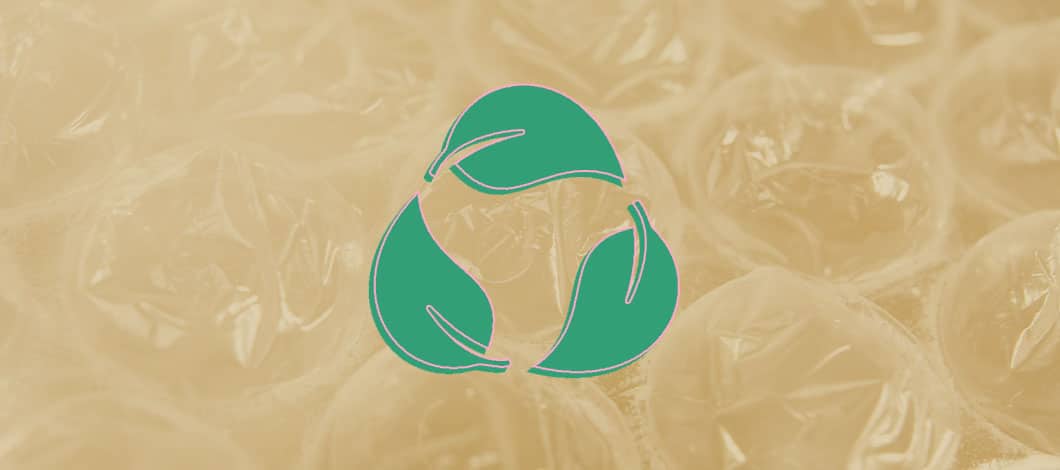Using alternative sustainable packaging materials helps the environment as well as your brand. To that end, we’ve gathered some top options for your business.
We’ll cover what sustainable packaging is and why you should use it before we look at 10 of the most useful eco-friendly packaging materials.
What Is Sustainable Packaging?
Sustainable packaging is storage and shipping material that avoids depleting natural resources. To achieve this, a sustainable approach to packaging deploys several core strategies, including:
- Refusing to use unsustainable materials (such as unrecyclable plastics)
- Reducing the use of sustainable materials (for example, using thinner containers)
- Reusing materials that don’t need to be thrown out (such as reusable plastic containers)
- Repurposing materials that can serve functions other than their original purpose (such as turning a shipping box into a storage container for a different item)
- Recycling materials (such as recyclable paper, cardboard and plastic)
Sustainable packaging materials are made from substances that lend themselves to these strategies. Some sustainable packaging examples are recyclable packaging and biodegradable packaging materials.
What Are the Benefits of Eco-Friendly Packaging for Small Businesses?
Sustainable packaging helps both the environment and eco-friendly businesses. For the environment, sustainable packaging materials preserve resources, reduce waste and lower the production of greenhouse gases.
For example, incineration of plastic packaging, which accounts for 40% of plastic demand, generated 16 million metric tons of carbon dioxide emissions worldwide in 2015, according to a study by the Center for International Environmental Law, a nonprofit group dedicated to strengthening environmental law. Sustainable packaging helps alleviate this type of problem.
Adopting a sustainable packaging policy can help your business, too. Practices such as reusing materials can help cut your packaging costs. Using sustainable packaging also improves your brand image in the eyes of eco-conscious consumers and business partners. Some 74% of consumers are willing to pay more for sustainable packaging, according to research by Trivium Packaging, a provider of recyclable metal packaging.

What Are Some Sustainable Packaging Materials?
What are the most useful sustainable packaging materials? Here’s a list of 10 eco-friendly packaging ideas which can help you implement a more sustainable policy.
For best results, use these materials in combination with smart sustainability policies. For example, consolidating shipments reduces the number of trips and mileage needed to ship your goods, conserving fuel and cutting carbon emissions. Developing arrangements with suppliers and customers to reuse shipping packages can increase the effectiveness of using sustainable materials.
1. Sustainable Cardboard
Containerboard, the material used to make cardboard boxes, is one of the most widely used packaging materials and is the single most recycled packaging material, according to the American Forest and Paper Association, a national trade association representing the paper and wood products industry. One environmental concern with cardboard boxes is that corrugated cardboard typically is bound by glue resins made from urea-formaldehyde, which can be toxic when released into the air or absorbed through the skin in quantities that exceed the body’s ability to break it down.
The Composite Panel Association (CPA), an organization representing the composite panel industry, has established an Eco-Certified Composite (ECC) sustainability standard to certify materials that contain low levels of formaldehyde and generate low levels of carbon emissions. The CPA works with partners to enforce similar standards, such as the Forest Stewardship Council’s Controlled Wood Standard and Chain of Custody Standard as well as the Sustainable Forestry Initiative’s Fiber Sourcing Standard. Look for cardboard that complies with the standards of the CPA and its partners.
2. Reusable Plastic Bins
Depending on your shipping and storage needs, another potentially useful alternative to cardboard boxes is reusable plastic bins. More durable than cardboard boxes, plastic bins can be used many times without being discarded, reducing the use of natural resources.
To maximize the use of this sustainability strategy, look for plastic bins made of recycled plastic or eco-friendly plastics. Alternatives to standard plastics include bioplastics, made from materials such as cornstarch that break down naturally, or biodegradable plastics, made from petrochemicals like regular plastics but engineered to break down more quickly.
3. Biodegradable Packing Peanuts
In the 1960s, Dow Chemical began selling packing peanuts made of polystyrene, better known under the brand name of Styrofoam. While useful for cushioning fragile objects, Styrofoam takes many years to decompose, which can leave packing peanuts piling up in landfills or the ocean.
To develop a more eco-friendly alternative, manufacturers have begun to make packing peanuts from biodegradable materials, which are materials that break down easily under natural conditions. One of the most popular alternative materials used is starch, which dissolves in water and can be added to compost piles.
The main con of starch-based peanuts is that they weigh more than Styrofoam peanuts, making them more expensive to ship. Do some cost calculations and comparisons before settling on this alternative. Product sourcing site Thomasnet.com provides an online supplier discovery platform you can use to research suppliers and compare costs.
4. Air Pillows
Air pillow packaging is another eco-friendly way to fill space between packaged items. They are inflatable, using air to cut down the amount of material used for cushioning. This makes them lightweight, which reduces shipping costs. They remain deflated until ready for use, reducing storage space required.
Air pillows can be reused, and some are made from materials that are recycled or biodegradable. However, not all air pillows have these properties, so look for brands that do when selecting suppliers.
5. Mushroom Packaging
Another innovative, eco-friendly alternative to packing peanuts is Mushroom Packaging. It has a composition resembling foam, but it’s made from mushrooms and hemp, allowing it to be composted. Suppliers can grow the material in the shape of a mold for customized packaging shapes.

6. Biodegradable Bubble Wrap
Another alternative packing material is biodegradable bubble wrap. While useful for cushioning packages, conventional bubble wrap is made of plastic, presenting waste-disposal issues. To address this problem, manufacturers have begun designing more sustainable types of bubble wrap.
One biodegradable alternative to bubble wrap is GreenWrap, which has a layered structure similar to tissue paper. Alternately, you can substitute corrugated cardboard for bubble wrap.
7. Newspaper
Newspaper offers another alternative packing material. Easy to recycle, newspaper can be used to cushion most of the same items as peanuts.
While fewer people today subscribe to printed newspapers than they once did, you still can find newspaper sources for packing purposes. Newspaper publishers and recycling centers will often sell old newspapers for discount rates.
8. Eco-Friendly Packaging Tape
Tape gets recycled with the shipping boxes it holds together. The recycling process removes unrecyclable components of tape. However, this removal process goes more smoothly when the tape’s face stock (the layer of material beneath the tape’s top coating) matches the packaging material your box is made of and when the tape’s adhesive layer separates cleanly.
One option is nonreinforced water-activated tape (WAT), which has a recyclable paper faces stock, dissolves and separates easily and lacks the fiberglass found in reinforced tape. This type of tape isn’t as strong as reinforced tape, so it’s not designed for very heavy boxes, and works best for cartons that are shipped on pallets rather than shipped individually. For heavier boxes, reinforced WAT has similar properties, but it has fiberglass which is removed during the recycling process.
9. Sustainable Mailing Bags
For items that would normally be shipped in plastic polyethylene (poly) mailer bags, there are a number of sustainable alternatives. Some eco-friendly mailers have microorganisms added to make them biodegradable. Others are made from plant materials such as field corn and wheat straw which are compostable.
10. Eco-Friendly Bottles and Jars
For liquid items, manufacturers have developed a number of more sustainable alternatives to plastic bottles.
For example, container supplier SKS provides packaging made from materials such as post industrial resin (PIR), which is made from leftovers of polypropylene plastic containers, keeping these materials from winding up in landfills. Other sustainable container materials include post-consumer resin (PCR), also made from recycled plastic, and paperboard, a thick paper that can be recycled.
Use Environmentally Friendly Packaging to Build a Greener Brand
Sustainable packaging seeks to preserve natural resources and protect the environment through strategies such as avoiding unsustainable materials and using materials that can be reused or recycled. Adopting a sustainable packaging strategy both helps the environment and helps your brand by allowing you to reduce waste and project a greener image.
Using the materials listed here and other sustainable materials can help you build a greener brand and make a more positive impact on the environment.










